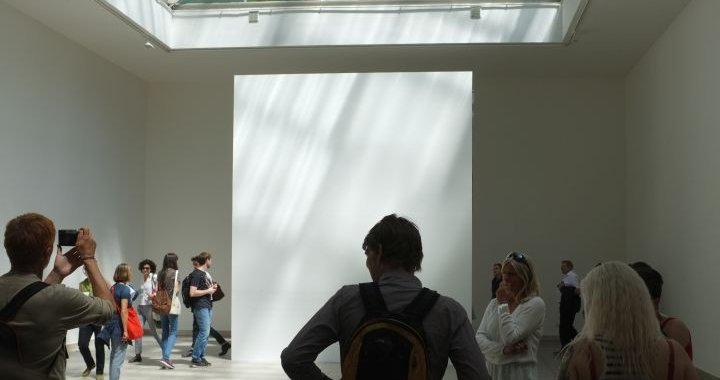
Touching the future from the past
Sergey Khachaturov
15/05/2015
This year is the 120th anniversary of the Venice Biennale. The curator that was invited this year is a powerful man, the Nigerian philosopher of culture, Okwui Enwezor. He called this year’s Biennale “All the World’s Futures”. The epigraph for this theme could be the “dialectical image” from Walter Benjamin: “Angelus Novus”. Walter Benjamin described the Angel that inspired him from a Paul Klee drawing: “A Klee drawing named ‘Angelus Novus’ shows an angel looking as though he is about to move away from something he is fixedly contemplating. His eyes are staring, his mouth is open, his wings are spread. This is how one pictures the angel of history. His face is turned toward the past. Where we perceive a chain of events, he sees one single catastrophe that keeps piling ruin upon ruin and hurls it in front of his feet. The angel would like to stay, awaken the dead, and make whole what has been smashed. But a storm is blowing from Paradise; it got caught in his wings with such violence that the angel can no longer close them. The storm irresistibly propels him into the future to which his back is turned, while the pile of debris before him grows skyward. This storm is what we call progress.” (from the “Ninth Thesis on the Philosophy of History”)
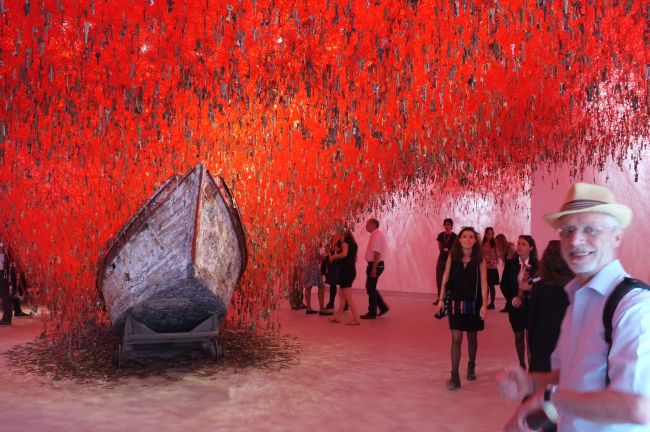
Chiharu Shiota. The Key in the Hand. Photo: Vladimir Svetlov
It is well known that Plato outlined the threshold of Philosophy as “astonishment”. The astonished Angel cannot foresee the future. He cannot change the past. However, in the past he is able to ascertain what Benjamin called “a hidden pointer, leading us to salvation.” In other words, the artist (creator) in the act of his creative insight seems to be warning mankind of the dangers that history is preparing for the future with the example of the past. There is no history in Paradise, because it contains the history’s beginning and end, therefore Paradise is not visible from here, it is not subject to the continuity of earthly space and time. And here is Benjamin's text on the subject: “Only the Messiah himself consummates all history, in the sense that he alone redeems, completes, creates its relation to the Messianic. For this reason nothing historical can relate itself on its own account to anything Messianic. Therefore the Kingdom of God is not the telos of the historical dynamic; it cannot be set as a goal. From the standpoint of history it is not the goal, but the end. Therefore the order of the profane cannot be built up on the idea of the Divine Kingdom, and therefore theocracy has no political, but only a religious meaning.” (from the “Theologico-Political Fragment”)
We were not given the ability to create a perfect world, but we are able to improve life for the better and to compare notes with the past: this is the chance we have got. And it is available to the artist’s viewpoint. The great cultural historian Alexander Mikhailov twenty years before Enwezor commented thus on the Angel of History: “The future does not become real until it becomes the past.” Consequently, all the possibilities for the future (following Enwezor’s main theme) involve tedious, maniacal (in its frenetic pedantry)collection of fragments of the very ruins seen by the Angel of History. The image of the future is then fortune-read from these fragments.
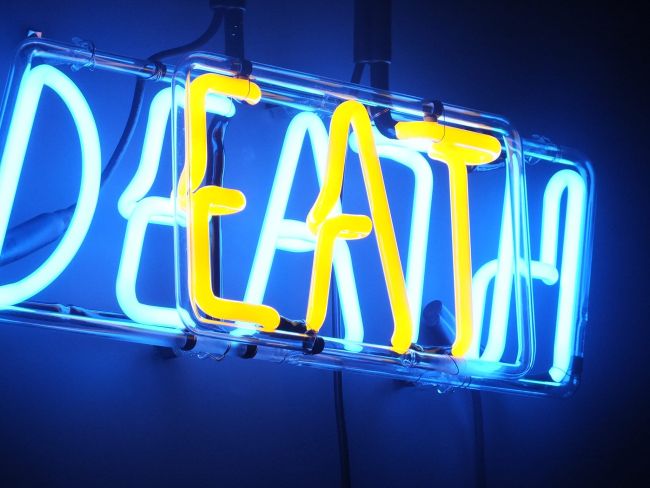
Bruce Nauman. Eat/Death. Photo: Sergey Khachaturov
Okwui Enwezor is a big master of the genre he coined as “the Parliament of Forms”. He collects a symposium of material evidence and texts from different cultures and civilizations with admirable care and with the skills of a great directorial performance. I was fortunate to have seen the previous grand performance thirteen years ago. In 2002, Okwui Enwezor was involved with the 11th “documenta” exhibition in the city of Kassel. At the time the theme of his extravagant “Parliament of Forms” was “post-colonial world”. The post-colonial world is not just fashionable words such as “identification” and “globalization”. It is also about crippled destinies, broken lives, suffering and grief. Politics make a fortune on dividends from grief, and skillfully manipulates it. Contemporary Art documents it. I remember the most brutal project of the 11th “documenta”: Untitled by the Cuban artist Tania Bruguera. You enter a dark corridor, turn the corner. Dozens of powerful searchlights blind you immediately in your face. The sounds of the machine gun being raked. Approaching footsteps. Pause. Panic... You frantically find the exit. You are free. The attraction is a torture device.
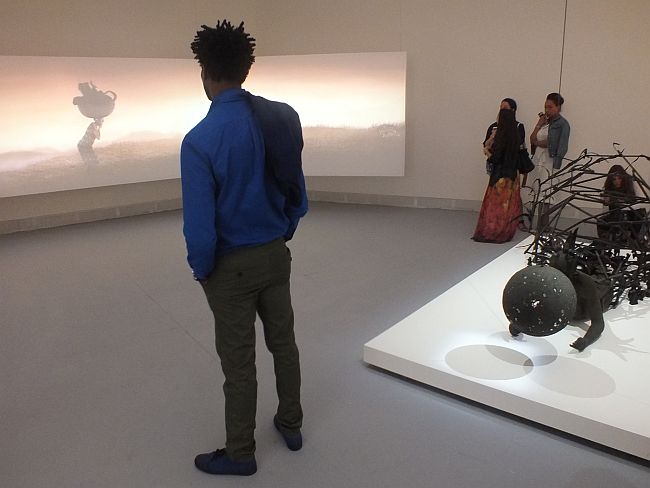
The audience in front of the video by a Kenyan artist Wangeti Mutu “The End of Carrying All”. Photo: Sergey Khachaturov
At this year’s Biennale Bruguera is also shown, as well as other artists from Latin American and African countries, which are all well represented in the main project. The fact that Enwezor is a good director and philosopher, and an interior designer of an intellectual salon, is proved by his ability to work systematically with the material, and to erect complex theoretical bases that is the foundation. In “documenta” this was the so-called “platforms”: conferences on the vital issues of our time, which took place over two years across the globe, from Vienna to Delhi. Now, in Venice, in his curatorial text, Enwezor suggested to relate his narrative with the major subjects of the previous two Biennales. The Biennale of 2011 was curated by Bice Curiger. It was called ILLUMINATIONS and it was devoted to the relationship between the artist and the viewer, the light of the art and its educational mission. The last Biennale, “The Encyclopedic Palace”, was initiated by Massimiliano Gioni as a way of finding inner impulses and incentives to creativity in a wide variety of people.
Enwezor structured his idea with the help of re-editing the pre-existing curatorial positions. The theme of finding something within (Gioni) and the analytical distance (Curiger) were integrated by Enwezor into a kind of kaleidoscope, a magic tube in which different pieces add up to whimsical visual and verbal texts. The distant point of view can change rapidly at a glance through a magnifying glass. That is why Enwezor chose three “filters” of the Biennale. The first is “The Garden of Disorder”; the second is "Liveness: on Epic Duration”; the third is “Capital: A Live Reading”. All three “filters” were placed in different audience traffic streams among the exhibited works. In the center of the main pavilion in Giardini (as part of the curatorial project) there was the ARENA: an amphitheater, where Das Kapital will serve as a kind of Oratorio that will be continuously read live. Karl Marx’s incorruptible work will be read, discussed, sung, made into the material of moldable musical exercises. In the above quoted thesis “On the Concept of History” Benjamin Walter took the Marxist point of view as an installment of critical thinking about the world of the historian: “The class struggle, which always remains in view for a historian schooled in Marx, is a struggle for the rough and material things, without which there is nothing fine and spiritual. Nevertheless these latter are present in the class struggle as something other than mere booty, which falls to the victor. They are present as confidence, as courage, as humor, as cunning, as steadfastness in this struggle, and they reach far back into the mists of time. They will, ever and anon, call every victory which has ever been won by the rulers into question. Just as flowers turn their heads towards the sun, so too does that which has been turned, by virtue of a secret kind of heliotropism, towards the sun which is dawning in the sky of history. To this most inconspicuous of all transformations the historical materialist must pay heed.” (from “On the Concept of History”)
So in order not to be considered dogmatic in relation to the anti-dogmatic Marx, let us recall the said Benjamin humor. Once during the Soviet era, foreign journalists asked whether people in the USSR counted their capital, and were answered by the popstar singer Alla Pugacheva thus: “We do not count our capital, we read ‘Das Kapital’.” Well, the dialectics of history show that the time has come to publicly read Das Kapital even in Western Europe.
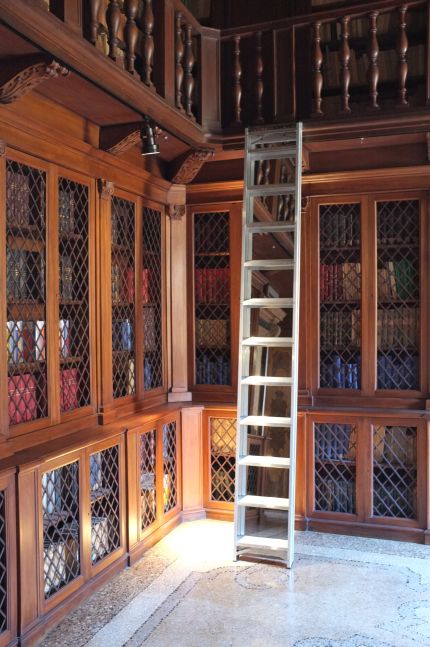
João Louro. I Will Be Your Mirror – Poems and Problems. Fragment of the exposition. Photo: Vladimir Svetlov
I will try to formulate a seditious thought: Okwui Enwezor’s curated programs are so self-sufficient that in general they do not need praises or criticisms from the large numbers of critics and other art bohemia that came to see them. The colossal scale and a certain totality of the current Venice Biennale convinces us that contemporary art, in its filtered intellectual presentation, is akin to algebraic formulas, or to doctoral theses. Unfortunately (or fortunately) it requires not the hedonistic delight but the comprehensive reading. It is comparable to what in Germany is called Fachliteratur (specialty literature). The endless and deliberately dismembered stream of images from different cultures made up of atoms of different phonetic constructs and linguistic morphemes is read with great effort and is similar to the meticulously assembled report on civilization (despite the weary sighs of artists and journalists) during the period of the recent historical ruins, disasters and hopes. That makes the heuristic moments of meetings with the harmony of form and meaning more valuable, therefore it does not become the deciding factor in this thesis. In Enwezor’s Central Hall I liked the variety of archaic forms of popular and traditional cultural expressions to impart the sharp actuality of the content. In particular, the Japanese artist Tetsuya Ishida, who died ten years ago, denounced technocratic consumerism by the means of sentimental painting which was somewhat similar to anime. A boy with sad eyes, tormented in the dungeons of the stone jungle, is waiting for fate to be dismantled into parts and folded into a neat box with a fashionable label. The South African artist Marlene Dumas presented the surreal dreams about painting and life as a anamnesis between existence and oblivion in the series called “Skull”. Incidentally, she just had a huge exhibition which just took place in the London Tate Modern. Her style is a kind of recollection of fragmentation of different naive methods of drawing, from children's drawings to the pictures in albums. It really fits well with Enwezor’s “Symposium Forms”.

In Jeremy Deller’s hall. Photo: Sergey Khachaturov
Next to Dumas’s artwork there is the incredible Jeremy Deller. He composed a document out of old photographs as a certificate of exploitation of labor in Victorian England. And he put the sounds of factories and machines into a jukebox from the first half of the 20th century. I think in general the once peripheral trend of “sound art” has now become an effective force in the organization of discrete and faceted communication with the world in its nonlinear and irrational summation. In the Central Hall the patriarch of conceptualism Charles Gaines presented an installation - “manifestos”: in the spaces between musical notes in classical opuses or folk songs political texts are read on the subject of racism and oppression. Music can be heard with these synthetic opuses. In the Arsenal (which is another part of the curatorial project) the American artist Jennifer Allora and Cuban artist Guillermo Calzadilla used combinations of various means of making music, from musical notation to flashbacks, to create soundscapes in which they aspire to get to the “heart of things”.
In accordance with the theme’s logic of leitmotifs of the curatorial project, these subjects come up: looking for an identity, the trauma of communication with the world; and also civilization versus ecology, the conflict of national cultures with globalization. The complete integration of the audience with the universal beauty of nature, and the horrifying experience of its tragedies, happens when you watch the three-screen video by John Akomfrah called “Vertigo Sea”, a project with brilliant rhythm and movement. The main subject of the video are whales who are being barbarically hunted.

John Akomfrah. Vertigo Sea
Projects of the curatorial performance in the Arsenal are more spectacular than in the central pavilion in the Giardini. However, the planned epic scale got a little lost as we moved deeper into the ancient warehouse of rifles and ships. This Biennale by Enwezor almost loses a little to his “documenta”, which observed the balance between spectacle with rhythm, space, pauses and sociological dissertation more accurately.
The Arsenal showed the Russian theme and the theme of relations in the post-Soviet space in an interesting way. It is seen by different artists as if through peripheral vision, which corresponds to the theme of the “summit debris of civilization” selected by Enwezor. The Parisian artist Liisa Roberts showed photos of people from the St. Petersburg subway in the interiors with Social Realist reliefs in the “Narvskaya” station. Australian artist Sonia Leber and English artist David Chesworth made a film called “Zaum Tractor”. It faces the experience of abstruse language of the Futurists, which becomes a commentary on the absurd realities of the post-Soviet life in the former Soviet Union. Olga Chernysheva fragments eccentricities and the touching absurdity of contemporary Russian life in her virtuoso drawings. Natalia Pershina (Gluklya) exhibited clothes embroidered with slogans (“Russia without Putin”) as a form of protest against the rigged presidential elections. Mykola Ridnyi from Kharkiv, who knows how to cautiously react to the tragic events in the relations between Russia and Ukraine, dedicated his photo project and graphics to the theme of the “blind spot”. This spot grows in the photos with the ruins of the destroyed eastern Ukraine. The blind spot is a part of the empty area between the right and left eyes, and it addresses the relationship with the present linked to the past and the future using a black hole.
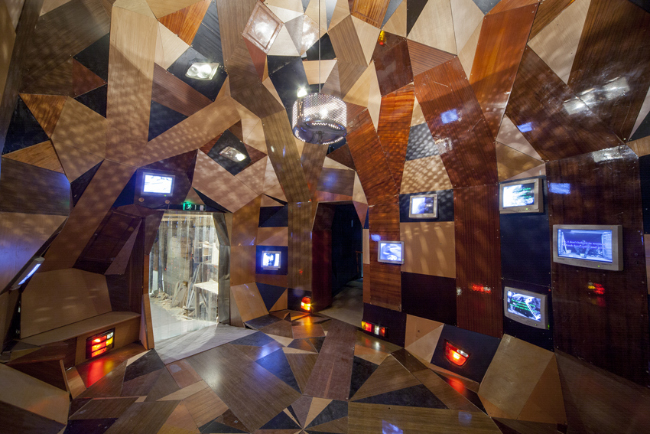
Katrīna Neiburga, Andris Eglītis. Armpit. Photo: Eriks Boze, Latvijas Laikmetīgās mākslas centrs
Characteristically, the archaeological expedition into the interior of the present and the past had in fact made many people turn away from the desire to turn towards their own future. The futuristic themes are rare for the Biennale. Among the successful are the ones that are dedicated to expeditions into new lands to ennoble human life and nurture a culture of dialogue with the world (the Antarctic pavilion Concordia by Alexander Ponomarev), as well as those in which futurology becomes the subject of funny and witty intellectual collages. Firstly, it is worth mentioning the exhibition “Future Histories” by Mark Dion and Arseny Zhilyaev (arranged by the foundation “VICTORIA — the Art of being Contemporary”). The artists created a kind of laboratory of artifacts from expeditions. Mark Dion travels back in time with Europeans from the Baroque era, as well as with Sir William Hamilton. Arseny Zhilyaev reinterprets Russian Space Art, urging OBERIU, Moscow Conceptualism (from Pepperstein’s period) and fantasy for kids, the readers of the magazine “Young technician” and “Murzilka”, to be his allies. The cynicism of the intellectual dandy disarms, in conjunction with sincerity and simplicity of the questioning man of the world from the questioning, confused generation. The image where an army of golden Chinese seals are waving their paws installed with a background of Malevich’s multiplied black squares seems stronger than the whole dull anti-utopian pavilion “Telluria” by Vladimir Sorokin.
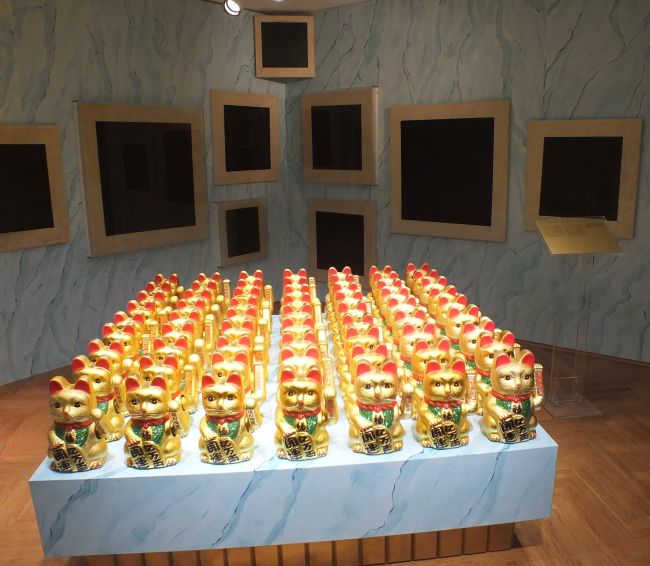
Photo: Sergey Khachaturov
From all the national pavilions I enjoyed the ones that tried to uphold the theme of “site specific”, or the ones that made installations in the present rich cultural context of Biennale’s and Venice’s history, in situ. Finally the golden lion for the Armenian pavilion as the best did not raise any questions. On the stunningly beautiful Armenian island of St. Lazarus in the lagoon in Venice there is a monastery full of historical and artistic artifacts, from ancient times until today. In the courtyard there is a fragrant garden with rare plants and flowers. Armenian artists of different origins (including Turkey) in the most delicate way introduced their exquisite visual representations through installations, drawings, and videos to the space of the island. The topics are the same: identity, trauma of history for which the medicine is letters and language. However, the context has helped all the messages to open up, so that the veil of weariness and satiety, which appeared after the laborious dialogue with miles of theoretical research that is Biennale, finally disappeared. My contact with the great culture of Armenia had a lively and intense impact on me.
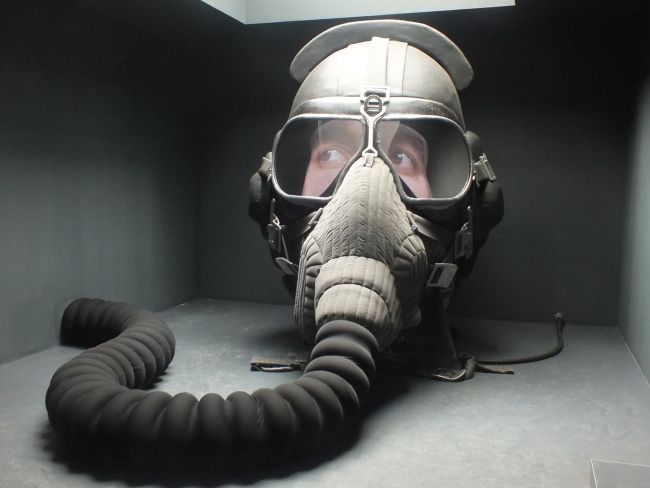
Irina Nakhova. The Green Pavilion. Photo: Sergey Khachaturov
Sincere engagement with good communication (and not appropriated by the globalization of the art world) could be identified by the visit to the exhibitions by Latvia (curators Kaspars Vanags and Victor Miziano) and Russia (the artist Irina Nakhova, the curator Margarita Tupitsyna). In the case of Russia, the success came from Enwezor’s idea of the appropriate way of looking at a new exhibition in a historical perspective. The exhibition by Irina Nakhova is a masterful embodiment of a journey through dreams, phobias and memories of the artist, and it is called “The Green Pavilion”. This is an homage to the exhibition by Ilya Kabakov, which was called the “Red Hall” 23 years ago. At the same time the Russian pavilion is a scheduled thread of dialogue with the latter two Russian programs, which exhibited the classics of Moscow Conceptualism, Andrei Monastyrsky and Vadim Zakharov. Irina Nakhova is a worthy conversationalist to both.
And finally, the wonderful projects devoted to the constants of the art language (Proportio in the Fortuny Museum) and the essential processes of the art of communication (the project of copies in classical art in Prada foundation) require a new format for conversation.